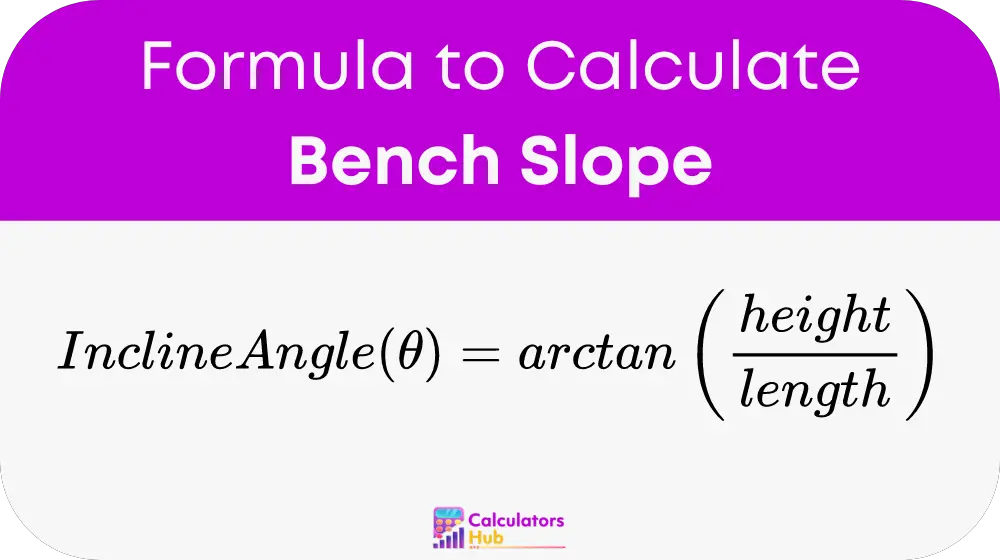The Bench Slope Calculator is a tool used to determine the incline angle of a bench, which is particularly useful for designing or adjusting workout benches, seating furniture, or other inclined surfaces. The slope or incline of a bench plays a crucial role in ensuring comfort, effectiveness, and safety during exercises or when used as seating. By calculating the correct angle, users can optimize the bench for its intended purpose, whether it's for strength training, ergonomic seating, or other applications.
This calculator helps users understand the relationship between the vertical height of the bench's backrest and the horizontal distance from the base to the point where the backrest meets the seat. By inputting these dimensions, the calculator provides the incline angle in degrees, making it easier to design or adjust the bench to meet specific needs.
Formula of Bench Slope Calculator
The formula to calculate the incline angle of a bench is as follows:

Where:
- θ is the incline angle of the bench, measured in degrees.
- Height is the vertical height of the bench's backrest from the ground, measured in the same unit as Length.
- Length is the horizontal distance from the base of the bench to the point where the backrest meets the seat, measured in the same unit as Height.
- arctan is the inverse tangent function, which calculates the angle based on the ratio of the height to the length.
This formula is derived from basic trigonometry, where the tangent of the angle is equal to the opposite side (Height) divided by the adjacent side (Length). The arctan function is then used to find the angle corresponding to this ratio.
Useful Conversion Table
Below is a table that provides common values and conversions that are frequently used when calculating bench slopes. This table can help users quickly determine the incline angle based on typical height and length measurements.
| Height (cm) | Length (cm) | Incline Angle (θ) |
|---|---|---|
| 30 cm | 50 cm | 31° |
| 40 cm | 60 cm | 34° |
| 50 cm | 70 cm | 36° |
| 60 cm | 80 cm | 37° |
| 70 cm | 90 cm | 38° |
This table provides a quick reference for users to estimate the incline angle based on common bench dimensions, making it easier to design or adjust benches for various applications.
Example of Bench Slope Calculator
Let’s consider an example where you want to calculate the incline angle of a bench with the following dimensions:
- Height: 45 cm
- Length: 75 cm
Calculation
Using the formula:
Incline Angle (θ) = arctan(Height / Length)
Substitute the values:
θ = arctan(45 cm / 75 cm) θ = arctan(0.6) θ ≈ 30.96°
Interpretation
The incline angle of the bench is approximately 31°. This angle is suitable for a variety of applications, including workout benches for exercises like incline bench presses or ergonomic seating.
Most Common FAQs
The incline angle of a bench is important because it determines the position and support provided during use. For workout benches, the angle can affect the muscles targeted during exercises, while for seating, it influences comfort and posture. A properly calculated angle ensures the bench is effective and safe for its intended purpose.
If the calculated angle is not ideal, you can adjust the height or length of the bench to achieve the desired incline. For example, increasing the height while keeping the length constant will increase the angle. While reducing the height or increasing the length will decrease the angle.
Yes, the Bench Slope Calculator can be use for various types of benches. Including workout benches, park benches, and seating furniture. The formula is universally applicable to any scenario where an inclined surface is need.